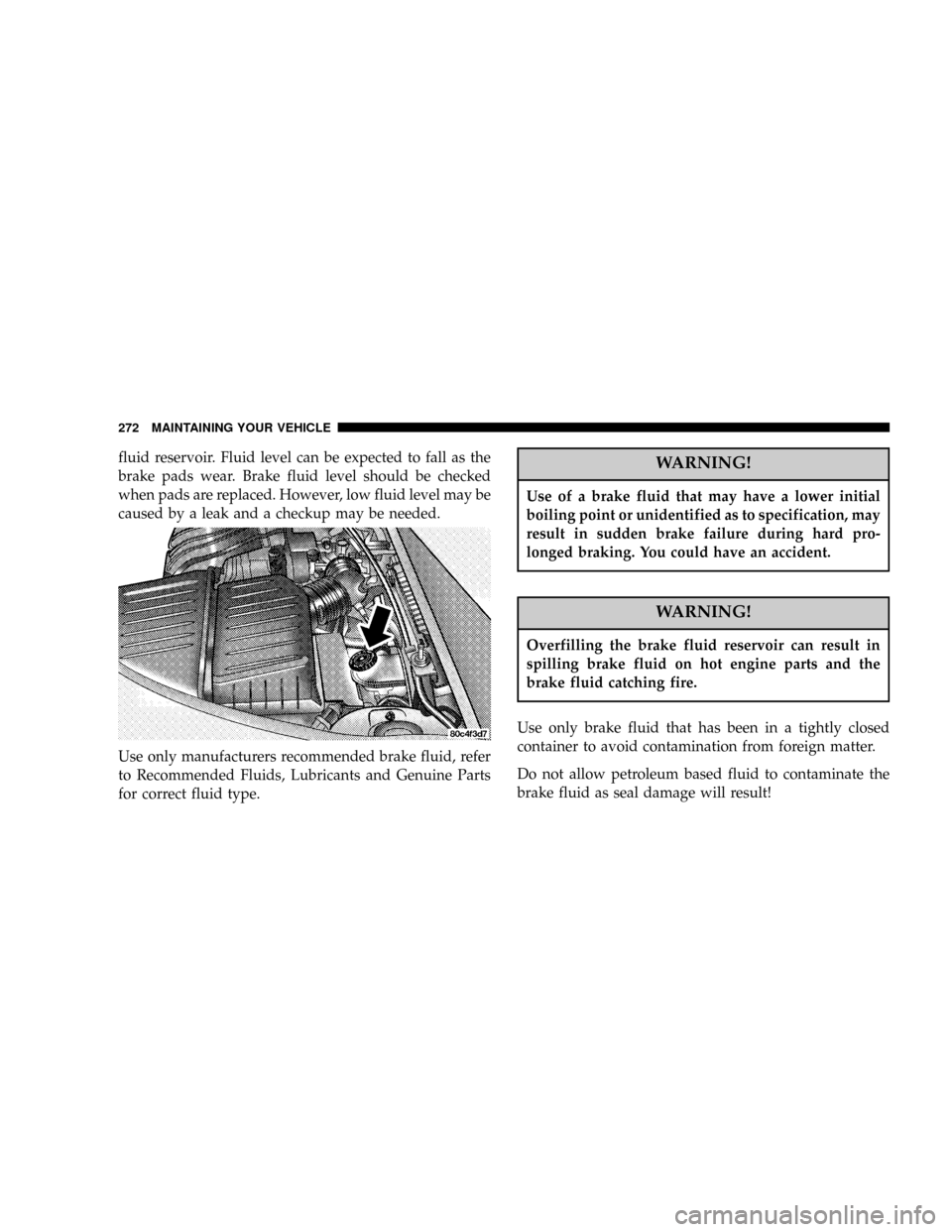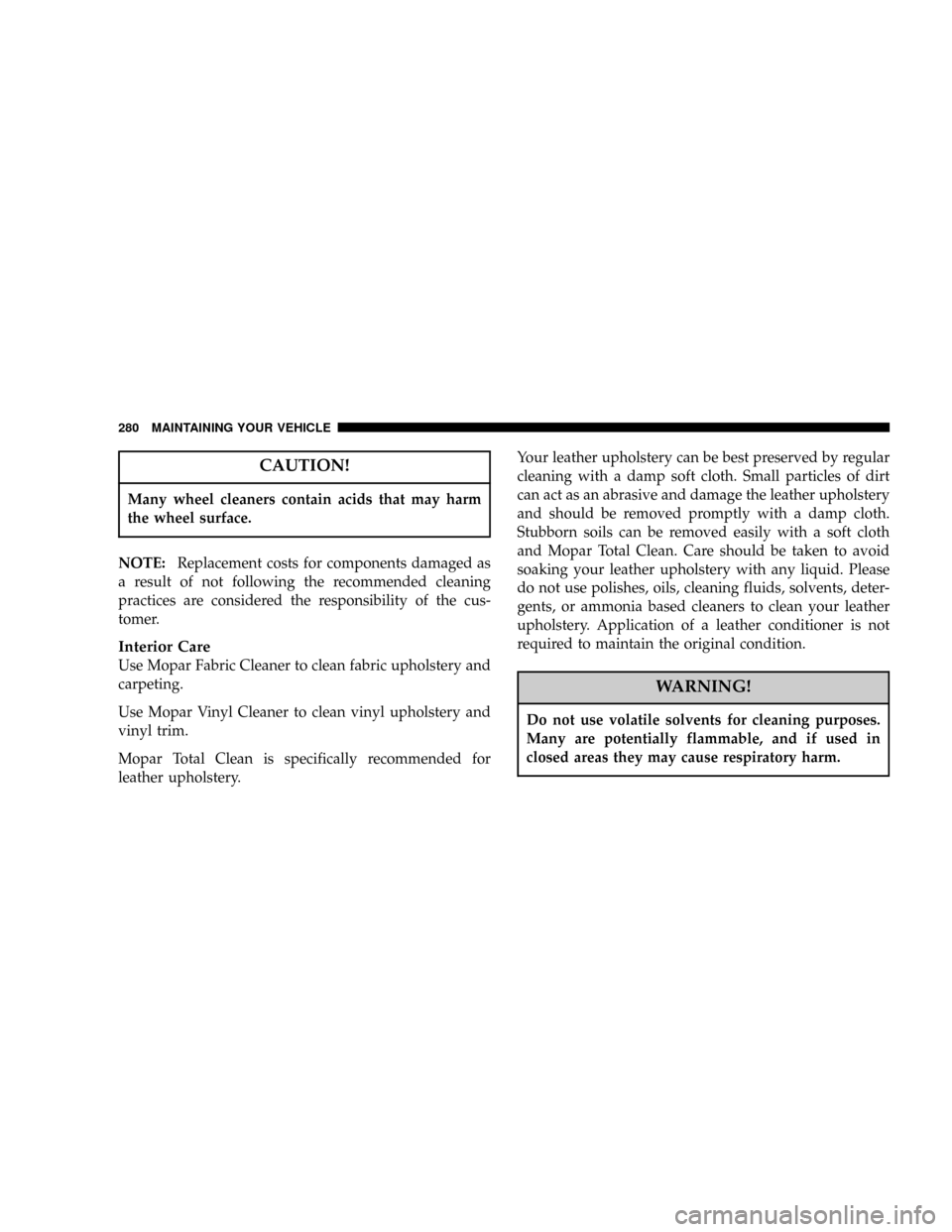warning CHRYSLER PT CRUISER 2004 1.G Manual Online
[x] Cancel search | Manufacturer: CHRYSLER, Model Year: 2004, Model line: PT CRUISER, Model: CHRYSLER PT CRUISER 2004 1.GPages: 341, PDF Size: 5.06 MB
Page 265 of 341

WARNING!
Exhaust gases can injure or kill. They contain carbon
monoxide which is colorless and odorless. Breathing
it can make you unconscious and can eventually
poison you. Follow the above precautions to keep
your exhaust system as safe as possible.
Cooling System
WARNING!
²When working near the radiator cooling fan, dis-
connect the fan motor lead or turn the ignition
switch to the OFF position. The fan is temperature
controlled and can start at any time the ignition
switch is in the ON position.
²You or others can be badly burned by hot coolant
or steam from your radiator. If you see or hear
steam coming from under the hood, don't open
the hood until the radiator has had time to cool.
Never try to open a cooling system pressure cap
when the radiator is hot.
MAINTAINING YOUR VEHICLE 265
7
Page 268 of 341

The cap should be inspected and cleaned if there is any
accumulation of foreign material on the sealing surfaces.
WARNING!
The warning words ªDO NOT OPEN HOTº on the
cooling system pressure cap are a safety precaution.
Never add coolant when the engine is overheated.
Do not loosen or remove the cap to cool an over-
heated engine. Heat causes pressure to build up in
the cooling system. To prevent scalding or injury, do
not remove the pressure cap while the system is hot
or under pressure.
Coolant Level
The coolant recovery bottle provides a quick visual
method for determining that the coolant level is ad-
equate. With the engine idling, and warm to normaloperating temperature, the level of the coolant in the
bottle should be between the ªFULLº and ªADDº marks.
The radiator normally remains completely full, so there is
no need to remove the radiator cap unless checking for
coolant freeze point or replacing coolant. Advise your
service attendant of this. As long as the engine operating
temperature is satisfactory, the coolant recovery bottle
need only be checked once a month.
When additional coolant is needed to maintain the
proper level, it should be added to the coolant recovery
bottle. Do not overfill.
Points To Remember
NOTE:When the vehicle is stopped after a few kilome-
ters (a few miles) of operation, you may observe vapor
coming from the front of the engine compartment. This is
normally a result of moisture from rain, snow, or high
268 MAINTAINING YOUR VEHICLE
Page 270 of 341

Insure nylon tubing in these areas has not melted or
collapsed
Inspect all hose connections such as clamps and cou-
plings to make sure the are secure and no leaks are
present.
Components should be replaced immediately if there is
any evidence of degradation that could cause failure.
Fuel System Connections
Electronic Fuel Injection high pressure fuel systems are
designed with tubes and special connects, connections
and clamps which have unique material characteristics to
provide adequate sealing and resist attack by deterio-
rated gasoline.
You are urged to use only the manufactures-specified
tubes, connections and clamps, or their equivalent in
material and specification, in any fuel system servicing.
Brake System
In order to assure brake system performance, all brake
system components should be inspected periodically.
Suggested service intervals can be found in the Mainte-
nance Section.
WARNING!
Riding the brakes can lead to brake failure and
possibly an accident. Driving with your foot resting
or riding on the brake pedal can result in abnormally
high brake temperatures, excessive lining wear, and
possible brake damage. You wouldn't have your full
braking capacity in an emergency.
Brake And Power Steering System Hoses
When servicing the vehicle for scheduled maintenance,
inspect the surface of the hoses and nylon tubing for
evidence of heat and mechanical damage. Hard and
270 MAINTAINING YOUR VEHICLE
Page 271 of 341

brittle rubber, cracking, tears, cuts, abrasions, and exces-
sive swelling suggest deterioration of the rubber. Particu-
lar attention should be made to examining those hose
surfaces nearest to high heat sources, such as the exhaust
manifold.
Inspect all hose clamps and couplings to make sure they
are secure and no leaks are present.
Insure nylon tubing in these areas has not melted or
collapsed.
NOTE:Often, fluids such as oil, power steering fluid,
and brake fluid are used during assembly plant opera-
tions to ease the assembly of hoses to couplings. There-
fore, oil wetness at the hose-coupling area is not neces-
sarily an indication of leakage. Actual dripping of hot
fluid when systems are under pressure (during vehicle
operation) should be noted before a hose is replaced
based on leakage.NOTE:Inspection of brake hoses should be done when-
ever the brake system is serviced and at every engine oil
change.
WARNING!
Worn brake hoses can burst and cause brake failure.
You could have an accident. If you see any signs of
cracking, scuffing, or worn spots, have the brake
hoses replaced immediately.
Brake Master Cylinder
The fluid level in the master cylinder should be checked
when performing under hood services, or immediately if
the brake system warning lamp is on.
Be sure to clean the top of the master cylinder area before
removing the cap. If necessary, add fluid to bring the
fluid level up to the requirements described on the brake
MAINTAINING YOUR VEHICLE 271
7
Page 272 of 341

fluid reservoir. Fluid level can be expected to fall as the
brake pads wear. Brake fluid level should be checked
when pads are replaced. However, low fluid level may be
caused by a leak and a checkup may be needed.
Use only manufacturers recommended brake fluid, refer
to Recommended Fluids, Lubricants and Genuine Parts
for correct fluid type.WARNING!
Use of a brake fluid that may have a lower initial
boiling point or unidentified as to specification, may
result in sudden brake failure during hard pro-
longed braking. You could have an accident.
WARNING!
Overfilling the brake fluid reservoir can result in
spilling brake fluid on hot engine parts and the
brake fluid catching fire.
Use only brake fluid that has been in a tightly closed
container to avoid contamination from foreign matter.
Do not allow petroleum based fluid to contaminate the
brake fluid as seal damage will result!
272 MAINTAINING YOUR VEHICLE
Page 280 of 341

CAUTION!
Many wheel cleaners contain acids that may harm
the wheel surface.
NOTE:Replacement costs for components damaged as
a result of not following the recommended cleaning
practices are considered the responsibility of the cus-
tomer.
Interior Care
Use Mopar Fabric Cleaner to clean fabric upholstery and
carpeting.
Use Mopar Vinyl Cleaner to clean vinyl upholstery and
vinyl trim.
Mopar Total Clean is specifically recommended for
leather upholstery.Your leather upholstery can be best preserved by regular
cleaning with a damp soft cloth. Small particles of dirt
can act as an abrasive and damage the leather upholstery
and should be removed promptly with a damp cloth.
Stubborn soils can be removed easily with a soft cloth
and Mopar Total Clean. Care should be taken to avoid
soaking your leather upholstery with any liquid. Please
do not use polishes, oils, cleaning fluids, solvents, deter-
gents, or ammonia based cleaners to clean your leather
upholstery. Application of a leather conditioner is not
required to maintain the original condition.
WARNING!
Do not use volatile solvents for cleaning purposes.
Many are potentially flammable, and if used in
closed areas they may cause respiratory harm.
280 MAINTAINING YOUR VEHICLE
Page 286 of 341

REPLACEMENT BULBS
LIGHT BULBS Ð Inside Bulb No.
ABS Indicator.......................... LED
Airbag Indicator........................ LED
Brake System Warning Indicator............. LED
Center Console Floor Lamp................. T37
Climate Controls......................6233137
Console Gear Selector...................PC194
Cruise Indicator....................... VFD*
Dome Light............................T579
Door Ajar Indicator..................... VFD*
Front Fog Indicator...................... LED
High Beam Indicator....................... 74
Instrument Cluster Illumination.............. 74
Liftgate Ajar Indicator.................... LED
Low Fuel Indicator....................... LED
Low Oil Pressure Indicator................. LED
Overhead Reading Light (Overhead Console). . . T1037LIGHT BULBS Ð Inside Bulb No.
Overhead Reading Light (Rearview Mirror).....T192
Rear Cargo............................T906
Seat Belt Indicator....................... LED
Security Alarm Indicator................... LED
Malfunction Indicator Light................ LED
Temperature Indicator.................... LED
Trac (Active) Indicator................... VFD*
TRAC OFF Indicator..................... LED
Trip Indicator......................... VFD*
Turn Signal Indicator...................... 103
Visor Vanity.........................6501966
Voltage Indicator........................ LED
NOTE:* Vacuum Fluorescent Display
All the inside bulbs are brass or glass wedge base.
Aluminum base bulbs are not approved and should not
be used for replacement.
286 MAINTAINING YOUR VEHICLE
Page 313 of 341
![CHRYSLER PT CRUISER 2004 1.G Manual Online Miles 110,000 115,000 120,000
(Kilometers) (177 000) (185 000) (193 000)
[Month] [90] [96] [102]
Change engine oil and engine oil filter. X X X
Inspect thePCV Valveand replace if necessary. * X
* This CHRYSLER PT CRUISER 2004 1.G Manual Online Miles 110,000 115,000 120,000
(Kilometers) (177 000) (185 000) (193 000)
[Month] [90] [96] [102]
Change engine oil and engine oil filter. X X X
Inspect thePCV Valveand replace if necessary. * X
* This](/img/25/8511/w960_8511-312.png)
Miles 110,000 115,000 120,000
(Kilometers) (177 000) (185 000) (193 000)
[Month] [90] [96] [102]
Change engine oil and engine oil filter. X X X
Inspect thePCV Valveand replace if necessary. * X
* This maintenance is recommended by the manufacturer
to the owner but is not required to maintain the emis-
sions warranty.
³ This maintenance is not required if previously replaced.
Inspection and service should also be performed anytime
a malfunction is observed or suspected. Retain all re-
ceipts.
WARNING!
You can be badly injured working on or around a
motor vehicle. Do only that service work for which
you have the knowledge and the right equipment. If
you have any doubt about your ability to perform a
service job, take your vehicle to a competent me-
chanic.
MAINTENANCE SCHEDULES 313
8
M
A
I
N
T
E
N
A
N
C
E
S
C
H
E
D
U
L
E
S
Page 324 of 341

WARNING!
The traction grade is based on braking (straight-
ahead) traction tests and does not include cornering
(turning) performance.
Temperature Grades
The temperature grades are A (highest), B, and C, repre-
senting the tire's resistance to the generation of heat and
its ability to dissipate heat when tested under controlled
conditions on a specified indoor laboratory test wheel.
Sustained high temperature can cause the material of the
tire to degenerate and reduce tire life, and excessive
temperature can lead to sudden tire failure. The grade C
corresponds to a level of performance which all passen-
ger car tires must meet under the Federal Motor Vehicle
Safety Standard No. 109. Grades B and A represent
higher levels of performance on the laboratory test wheel
than the minimum required by law.
WARNING!
The temperature grade is established for a tire that is
properly inflated and not overloaded. Excessive
speed, underinflation, or excessive loading, either
separately or in combination, can cause heat buildup
and possible tire failure.
324 IF YOU NEED CONSUMER ASSISTANCE
Page 326 of 341

ABS (Anti-Lock Brake) System.............. 194
Adding Engine Coolant (Antifreeze).......... 267
Adding Fuel........................... 221
Adding Washer Fluid..................... 175
Additives, Fuel......................... 219
Air Cleaner, Engine...................... 258
Air Conditioning........................ 261
Air Conditioning Controls................. 166
Air Conditioning, Operating Tips............ 171
Air Conditioning Refrigerant............... 261
Air Conditioning System................166,261
Air Pressure, Tires....................... 207
Airbag................................ 41
Airbag Deployment....................... 48
Airbag Light.....................45,50,60,134
Airbag Maintenance....................... 49
Airbag, Side............................ 47
Alarm, Panic............................ 23
Alarm System........................26,129Alignment and Balance................... 213
Alterations/Modifications, Vehicle............. 7
Antenna, Satellite Radio................... 164
Antifreeze (Engine Coolant)...........267,290,291
Capacities........................... 290
Anti-Lock Brake System................... 194
Anti-Lock Warning Light.................. 131
Anti-Theft Security Alarm.................. 26
Appearance Care........................ 276
Auto Down Power Windows................ 31
Automatic Door Locks..................... 20
Automatic Transaxle..............12,180,183,273
Fluid and Filter Changes................. 275
Fluid Level Check...................273,274
Interlock System.....................18,184
Reset Mode.......................... 184
Selection Of Lubricant................... 273
Shifting............................. 185
Special Additives...................... 276
326 INDEX